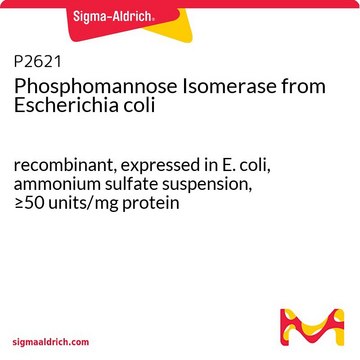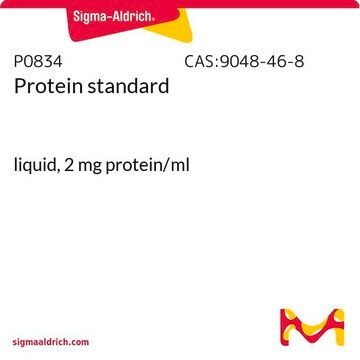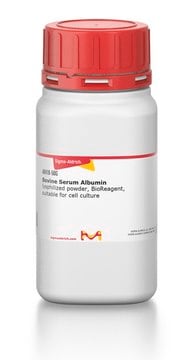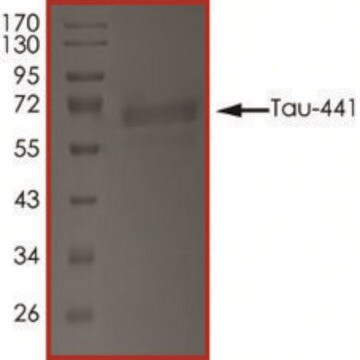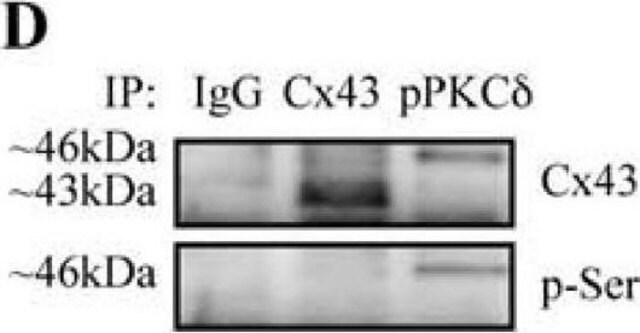P3967
Phosphotyrosine-BSA
2 mg/mL, buffered aqueous solution
Sinonimo/i:
P-tyr-Bovine Serum Albumin
Autenticatiper visualizzare i prezzi riservati alla tua organizzazione & contrattuali
About This Item
Prodotti consigliati
Sterilità
non-sterile
Livello qualitativo
Stato
buffered aqueous solution
Concentrazione
2 mg/mL
tecniche
capture ELISA: 5 μg/mL using Platelet extract (Use Sigma Monoclonal Anti-Phosphotyrosine Antibody (Prod. No. P3300))
western blot: 5 μg/mL using Platelet extract (Use Sigma Monoclonal Anti-Phosphotyrosine P-3300)
Condizioni di spedizione
dry ice
Temperatura di conservazione
−20°C
Descrizione generale
The activity of proteins depends on phosphorylation of specific amino acid residues. In applications involving identification of activated cellular proteins, it is important to confirm specificity of antibodies used against a particular phosphorylated amino acid. For such applications, inhibitors of phosphorylated antibodies on specific amino acid residues are suitable. Phosphotyrosine antibody inhibitor may be used for the specific inhibition of the reactivity of anti-phosphotyrosine antibodies but not that of anti-phosphothreonine- or anti-phosphoserine-specific antibodies.
Specificità
Phosphotyrosine antibody inhibitor that specifically blocks the reactivity of anti-phosphotyrosine antibody. It does not block the activity of anti-phosphothreonine or anti-phosphoserine-specific antibodies.
Applicazioni
Phosphotyrosine-BSA may be used for specific inhibition of phosphotyrosine in platelet extracts, in immunoblotting and ELISA applications, at a working concentration of 5 μg/mL.
Stato fisico
Solution in 0.01 M phosphate buffered saline, pH 7.4, containing 15 mM sodium azide.
Risultati analitici
O-Phospho-L-tyrosine conjugated to bovine serum albumin
Esclusione di responsabilità
Unless otherwise stated in our catalog or other company documentation accompanying the product(s), our products are intended for research use only and are not to be used for any other purpose, which includes but is not limited to, unauthorized commercial uses, in vitro diagnostic uses, ex vivo or in vivo therapeutic uses or any type of consumption or application to humans or animals.
Codice della classe di stoccaggio
10 - Combustible liquids
Classe di pericolosità dell'acqua (WGK)
WGK 3
Punto d’infiammabilità (°F)
Not applicable
Punto d’infiammabilità (°C)
Not applicable
Scegli una delle versioni più recenti:
Possiedi già questo prodotto?
I documenti relativi ai prodotti acquistati recentemente sono disponibili nell’Archivio dei documenti.
Motoyuki Ogawa et al.
Biochemical and biophysical research communications, 304(4), 676-683 (2003-05-03)
Paxillin has been recognized as a focal adhesion adapter protein that participates in the integrin-mediated signaling. An earlier study [Ogawa et al. Biochim. Biophys. Acta 1519 (2001) 235] found that frog paxillin was expressed in the kidney epithelial cell line
Birte Schulenberg et al.
Electrophoresis, 25(15), 2526-2532 (2004-08-10)
Protein phosphorylation plays a vital role in the regulation of most aspects of cellular activity, being key to propagating messages within signal transduction pathways and to modulating protein function. Pro-Q Diamond phosphoprotein gel stain is suitable for the fluorescence detection
Zhihong Zeng et al.
The Journal of biological chemistry, 286(1), 403-409 (2010-10-30)
Topoisomerase II (Top2) activity involves an intermediate in which the topoisomerase is covalently bound to a DNA double-strand break via a 5'-phosphotyrosyl bond. Although these intermediates are normally transient, they can be stabilized by antitumor agents that act as Top2
Matthew G Vander Heiden et al.
Science (New York, N.Y.), 329(5998), 1492-1499 (2010-09-18)
Proliferating cells, including cancer cells, require altered metabolism to efficiently incorporate nutrients such as glucose into biomass. The M2 isoform of pyruvate kinase (PKM2) promotes the metabolism of glucose by aerobic glycolysis and contributes to anabolic metabolism. Paradoxically, decreased pyruvate
Jacqueline Fischer-Lougheed et al.
Immunology, 123(3), 390-397 (2007-10-06)
Synthetic anti-idiotypic antibodies represent a potentially valuable tool for the isolation and characterization of B cells that produce xenoantibodies. An anti-idiotypic antibody that binds to a subset of B cells producing antibodies encoded by the variable-region heavy chain 3 (V(H)3)
Il team dei nostri ricercatori vanta grande esperienza in tutte le aree della ricerca quali Life Science, scienza dei materiali, sintesi chimica, cromatografia, discipline analitiche, ecc..
Contatta l'Assistenza Tecnica.
